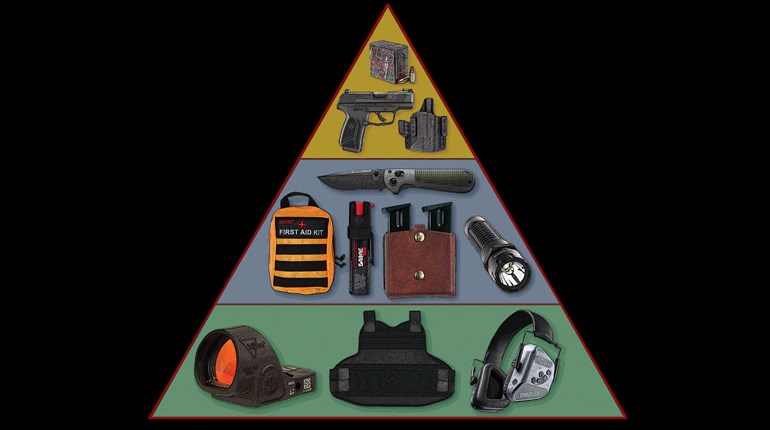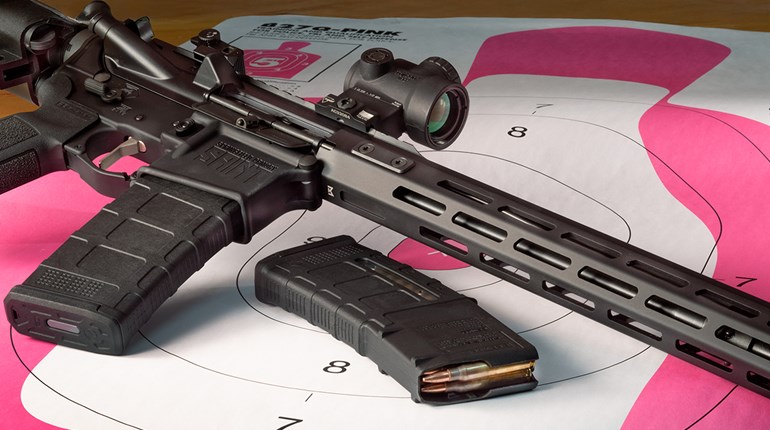
For many people, carrying a firearm in their vehicle is more comfortable than carrying a firearm on their body. It is perceived to be close by or handy while in the car. I may not agree with their rationale, but I know it happens. As more and more folks return to the workforce, we will see an increase of firearms carried in vehicles. In addition, several states have new laws coming into effect that could also change the way some carry concealed. Whatever the reason, there may come a time you need to store your firearm in your vehicle. To many, storing a firearm in the vehicle means hiding it under the seat or in the center console. These are less-than-ideal choices and should be avoided when possible. Let’s examine some of the situations where you may be required to secure your firearm in your vehicle and some considerations to do so safely and tactically.
There are a lot of reasons why folks may carry a firearm in their vehicles. For some, it is part of their self-defense strategy, for others it is a requirement due to a prohibitive work environment and there are a lot of folks who fall in between. The idea of stowing your firearm in your vehicle is not a new one, but has changed over the years. Gone are the days where you could nonchalantly leave your gun in an unlocked glove box. Great care must be taken to ensure your firearm is secured from unauthorized access. Of course, you have to consider theft—and not just the theft of your firearm, but also your vehicle with the gun secured within. Should your vehicle be stolen for the sake of vehicle theft, the thieves have now acquired a firearm or more.

I generally break firearm storage in vehicles into three categories: self-defense option, prohibitive work environment and interstate travel.
Those who choose to secure a firearm in their vehicle may do so because it is part of their self-defense strategy. They may feel less comfortable carrying on their body for a number of reasons:, they are new to firearms, they wear a restrictive wardrobe or they have a lack of confidence, to name a few. Having the firearm readily accessible in their vehicle appears to be a happy medium. Before you consider this option, however, make sure you know the law. Is a firearm in “plain sight” considered legal in your jurisdiction or any through which you regularly travel? Even if it is stored in a manner that is semi-permanent and convenient, does this constitute “plain sight?” What does “readily available” mean in the eyes of the law? Moreover, keep in mind that these types of storage options do not provide much security from theft. Plus, depending on the law, they may complicate interaction with law enforcement during traffic stops. It may seem like a good idea to keep the firearm handy, but few if any of these methods are smart or sensible. When you leave your vehicle, could leaving the firearm in these locations be more viewable to passersby, inviting theft?
If we factor in the number of hours a year we spend commuting, it might surprise you. It may seem as though it is a well-planned contingency should you find yourself in a violent attack in or near your vehicle. But, let’s think about the types of violent attacks that happen in and around vehicles. One type that comes to mind is carjacking. Is your personal property, in this case your vehicle, worth responding with deadly force? Maybe. If you are responsible for other passengers and you cannot guarantee their safety, you may be forced to act to stop a threat. In this case, does having a firearm stored in this matter offer you an advantage? Depending on the situation, probably not. The moment the door is opened, the clock is ticking. You must come up with a cover for action that allows you to reach for firearm or risk the assailant seeing it before it can it be deployed, or you might have to surrender the vehicle with the gun in it. These types of situations happen quickly, and if your window of opportunity was small and limited to being inside the vehicle, the moment you exit the vehicle the firearm is no longer an option for you.
If your place of business is a prohibitive work environment and does not permit you to carry your firearm inside its facilities, then storing your firearm becomes a requirement. You could leave your firearm at home. However, with the amount of commuting many Americans do these days, it is more appealing to carry to work. In this case, you will need to secure the firearm in your vehicle once parked at work. Again, your first consideration should be whether it is permitted to secure your firearm in your privately owned vehicle on business grounds—typically in a parking lot on private property. If it is permitted to secure the firearm in your vehicle, it becomes very important you do so in a discreet manner. There are many ways of carrying a firearm, but the vast majority of them include a reliable holster. My suggestion is when it comes time to secure your pistol, you remove both it and the holster as a single unit. This protects the handgun’s trigger from being accidentally contacted. An essential requirement of a holster is to protect the trigger from unauthorized access. Taking off the firearm and holster in this manner makes it a safer action. I recommend to first develop a system, then use this system any time you must secure a firearm in your vehicle.

The system I recommend starts with you checking your surroundings. Is anyone watching or able to see you and your actions? If so, just wait. Checking your smartphone is a great cover for action while you wait for a passerby to go about their business. Once the coast is clear, identify a safe direction you will point the muzzle while you remove the firearm/holster—that bit of Kydex or leather that might cover the muzzle while the gun remain sin the holster isn’t going to stop or even slow down a bullet. Keep the muzzle pointed in this direction all the way to your secured storage option. If the secured storage is located inside the vehicle, it might be a little challenging. If outside, it can be a little easier to facilitate safe direction.
When selecting a secure-storage container, a major consideration is whether you can store the firearm and holster together. Some units are small and space may be limited, so do some research. Whatever safe storage you choose, it must be affixed somehow to your vehicle. When you return to your vehicle from work, start by checking your surroundings, then gain access to your secured storage. Remove the firearm/holster while maintaining the muzzle in a safe direction, then attach it to your body.
The legality of carrying on your body can be somewhat easy to ascertain; since most states have decent websites that provide information regarding carry-permit reciprocity or lack thereof.
When it comes to traveling outside your home state (or a state for which you possess a valid concealed-carry permit), you really have to do your homework. You must research the law, specifically on carrying a firearm on your body and in your vehicle. The legality of carrying on your body can be somewhat easy to ascertain; since most states have decent websites that provide information regarding carry-permit reciprocity or lack thereof. If your home state and the state you are visiting do not have reciprocity (or the state you visit is not a Constitutional-carry state for non-residents), then should you decide to travel with your firearm, you know it must not be on your body. This means you have to store the firearm securely in a manner that meets or exceeds the state’s requirements. Again, this is where you must conduct thorough research to determine whether it is legal to even travel within the state with a loaded firearm in the passenger compartment of a vehicle. Some states are very extreme in this regard, and even traveling through is can result in strict penalties up to and including jail time. This is particularly true if you intend to stop, even for gas or a rest, and of course should you be pulled over by law enforcement for a traffic violation.
If you research and discover it is pretty complex or difficult to locate accurate information, calling the state’s issuing authority and asking for clarification is one option, although one I’m not too fond of for the simple reason you are speaking with someone who must interpret the law. You will have a hard defense on your hands if they were wrong or failed to cover all the details. Ideally, they should be able to direct you to a resource where you can read and print the information so you can have it with you while traveling. Printing it off, highlighting the passages that discuss traveling and, even better, asking a legal resource to review and, if necessary, interpret the language of the law can go a long way toward understanding the requirements. “The Traveler’s Guide to the Firearm Laws of the 50 States” is an excellent resource, but be aware that laws are constantly changing, so while it is a great starting point, you still need to make sure the information has not changed since the time of publication. Of course, if you discover going armed on a particular trip results in too much hassle, you might reconsider leaving the gun at home or not traveling to that state in the first place. While disappointing, it may make for the more responsible decision on your part.

If you intend to carry a firearm in your vehicle as you travel from one state to another after researching the law, you may decide you have a good enough grasp to continue. If you must secure the firearm to meet some sort of legal requirement, I suggest you go above and beyond your interpretation of the law. For instance, you may start by confirming the firearm is unloaded and secure it with the lock that came with the gun when you purchased it. You may then secure it in some sort of lockable container. Then, take the firearm and secure it in your luggage. It is buried three layers deep, making it next to impossible that it could be perceived as readily available.
A note on ammunition is also needed. If you are going to all this trouble to secure your firearm, you would also need to take similar precautions with your ammunition. If your magazines are loaded, remove the ammunition and secure the rounds in their factory box if still available. Then, secure the ammunition in some sort of lockable container. The important message to convey is the firearm and ammunition are not stored together. Also, be aware that some jurisdictions stupidly ban certain types of ammunition, even for law enforcement, so be sure you know the regulations in this arena, too.
There are lots of reasons we may travel with firearms in our vehicles. If we do, knowing the law is the first step in making sure we do so legally. Having a safe and secure storage device—preferably attached to your vehicle—allowing you to lock your firearm would be the next step. If you feel more comfortable with the firearm in your vehicle as opposed to on your body, then a safe and secure method of storing the firearm is a must. If you have to store the firearm in your secure case because your work is a prohibitive location, then having a system in place to make sure you can safely and discreetly store your firearm is smart. If traveling outside your home state, give some consideration to leaving it behind, or going out of your way to scrupulously follow all laws when traveling. These are just a few things to consider when carrying firearms in your vehicle.



































